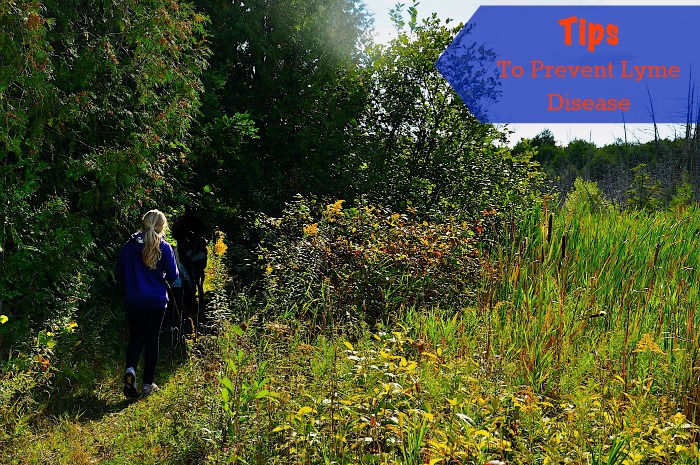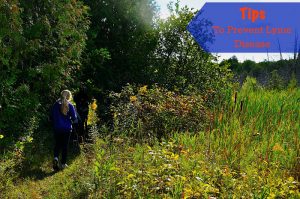
As Canadians and Americans send their children to camp or head out for annual camping trips, local public notices flood the airwaves — or inboxes — with warnings about all manner of insects and the diseases they transmit. One of the most debilitating of these is Lyme disease, which is caused by the bite from infected blacklegged ticks. According to the Public Health Agency of Canada, not all ticks are infected with the bacterium Borrelia burgdorferi, but the numbers are increasing and their range is spreading. Before all of you would-be campers and outdoorsmen run for cover to sanitized air-conditioned shopping centres, take a few minutes to learn the facts and then take preventative measures to ensure the summer camping season goes off without a bite.

- The four stages of a tick: larva, nymph, adult male, adult female.
What To Look For And Prevention:
- Ticks are small, measuring between 1-5 millimeters, and range in colour from reddish-orange to brown and black.
- They live in overgrown areas between forests and open spaces and are most common in Ontario along the north shores of the Great Lakes, along the southern areas of British Columbia, Manitoba, Quebec, and the Atlantic Provinces, as well as northeastern and upper midwestern United States.
- Wear closed toe shoes and long pants when hiking with socks pulled over the pant legs.
- Light coloured clothing helps for spotting ticks.
- Wear an insect repellent that contains DEET or Icaridin.
- Shower or bathe within two hours to wash away any loose ticks.
- Do a body check of children, pets, and yourself after a hike.
How To Know You’ve Been Bitten & What To Do
- If the tick has fallen off you might not realize you’ve been bitten since tick bites are almost painless.
- If you find a tick remove it using tweezers within 24-36 hours. Grasp it as close to its head as possible with the tweezers.
- Wash the bite area or disinfect it with alcohol or hand sanitizer.
- A rash or red spot may develop around the site of the bite. If Lyme disease is present this can become a large red rash.


Not everyone who is bitten by an infected tick experiences symptoms of Lyme disease, and these often don’t present for several weeks following exposure. Symptoms can range from fatigue, headaches, skin lesions, and swollen lymph nodes, among others. Contact a health provider immediately if you experience these symptoms following a bite. If left untreated Lyme disease can cause a range of health issues affecting the skin, joints, and nervous system. Early diagnosis is essential to successful treatment, which is typically a round of antibiotics.
This may all seem gruesome — and frankly, gross — but following the preventative tips listed here will greatly minimize any risks, even for campers heading into the deep woods. There are also tick repellents available for pets that will prevent Kujo from bringing home unwanted pests when he’s been chasing squirrels.
So…now that we’re all scratching and itchy and checking under hairs and flaps, let’s go camping! But remember to wear long pants and bug repellent.
Tick image source Fairfax County’s Flickr and their Creative Commons License, and Wikimedia Commons.



 Summer Weekend Getaway in Toronto
Summer Weekend Getaway in Toronto
Leslie
Ick! Just as I’m packing to head out camping. Thanks for the info Katja.
Brandy
We’ve never had ticks up here in Northern Manitoba but in the last two days, three different people have posted pictures of ticks they found on their kids or pets. I am freaking out. hehe!
peady
In Nova Scotia we have a known carrier of Lyme Disease in the Black Legged Tick (Deer Tick) and lots of warnings about them. They are becoming more prevalent. ( http://www.cdha.nshealth.ca/public-health/get-tickd/what-ticks-look ) I *shudder* when I think about them. They are teeny, even the big ones, and they are not painful and can hide in folds and nooks and crannies. Ick!
It’s really important to get the facts and be aware. Do not freak out! (I’m looking at you, Brandy!) It’s much better to deal.
Also, it’s important to note that while the “bull’s eye” is often (but not always) seen and associated with Lyme Disease, it doesn’t mean you have it. (Again, do not freak out!)
My daughter had a very classic bull’s eye last summer and we took her to see our Family Doc (to be on the safe side) and it was determined that it was likely a spider bite. Our Dr. shared that she has had a similar skin reaction from spiders.
Sadly, and much to the chagrin of her brother, it was not a radioactive spider bite. 😉
Katja
You’re welcome. Have a good trip!
Katja
It’s crazy! According to the government of Canada web site they’re spreading. Lots of bug spray!
Katja
A radioactive spider bite would have been so much more fun. Information is key for Lyme disease and ticks.
Katja
It’s crazy, Brandy! According the the government of Canada web site they’re spreading. Lots of bug spray.
peady
It would have been. I am envisioning the speedy pick up of the messy bedroom floor with that convenient webbing!
Also, Information is key!
(And you meant for me to think about pie, right? Right? No. Just me then.)
Sarah Robinson
And now I’m all itchy-scratchy-creeped-out blegh!
Katja
Fun times, right?
Mari
Thanks Katja for such an well-written article on what I need to know on this! Lots of info out there but this was straight-forward. We’re doing a lot of camping this summer and I don’t want to be paranoid the whole time! 😉
Margaret Miller
I’d like to add don’t wear the same pants the next day if you go hiking. Ticks can live on your clothes for 24 hours. They might have been on the outside and then climbed to the inside while your pants lay on the floor over night.
Candace Derickx
That is an excellent point! Thanks Margaret!